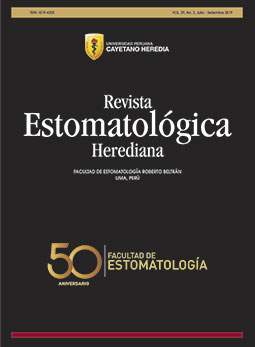Frecuency of the mentonian nerve loop in computed cone beam computed tomography at the Hospital Nacional Cayetano Heredia
DOI:
https://doi.org/10.20453/reh.v29i3.3600Keywords:
Mental hole; anatomic variation; cone beam computed tomography.Abstract
Objective: This study purpose is to determine mental nerve loop frequency in patients of the Oral and Maxillofacial Radiology Service of Stomatological Diagnostic Support Unit of Odontoestomatology Department of Cayetano Heredia Hospital, 2016-2017 period. Material and Methods: A descriptive, retrospective and cross-sectional type was present study. We analyzed 181 cone beam computed tomographies selected according to inclusion and exclusion criteria, and evaluated mental nerve loop with respect to its presence or absence and its respective characterization. For the analysis, descriptive statistics and Chi square test were used at a 95% confidence interval, and a significance level of 0.05. Results: There were 97 findings of mentonian nerve loop that represent 53.6% patients, of which 74.2% were female. The findings predominated in the group of 20 to 29 years with 28.9%. According to the distribution area, the majority were on the left side (23.8%). As for the length, a minimum of 0.12 mm and a maximum of 7.62 mm was found. Conclusions: The findings prevailed in the female sex and in the left side, likewise it was verified as a mean measurement for the 3.04 mm mental nerve loop, these results will later serve to implement routine radiographic search of the mentioned neurovascular package, previous to surgical treatments in mental foramen area.
Downloads
Published
How to Cite
Issue
Section
License
The authors retain the copyright and cede to the journal the right of first publication, with the work registered with the Creative Commons License, which allows third parties to use what is published as long as they mention the authorship of the work, and to the first publication in this journal.




















